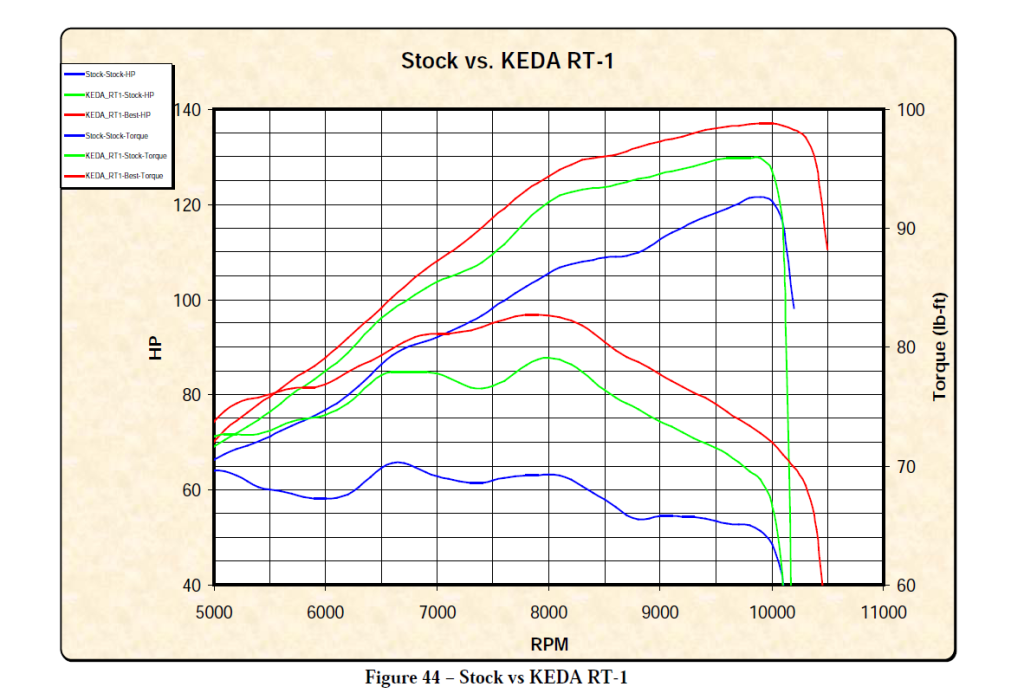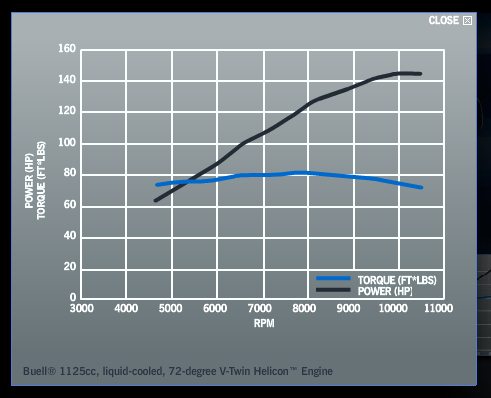| Author | Message | ||
Kinder |
Since it looks likes no new stock header to replace the mod'd one for me for a while as I can't find one.  So with fixed TPS, stacks and a Barker off to the Dyno I went. Installed the PCV but set it for a zero map. That means it would not try to change anything. Will post graphs Tuesday. Results... Remember with the TPS at 67% she pulled 103/63 bone stock 99/64 with new equal length header Well with TPS at 100% (going by memory) 110/66 w. equal headers 110/66 w. stacks (but a lot smoother curve) 110/66 w. stacks and Barkers. WTF!!! I gots nothing.... just disappointment from the first pull and on. Gonna try tuning next but will prob wait till I get a new front pipe and then try again. Sad I am.  | ||
D_adams |
http://www.erikbuellracing.com/store/parts-accesso ries/used-take-offs/1125-header-set.html | ||
Bueller4ever |
What did the AFR look like? What were your AFV's? There are only a handful of stock 1125's that have dyno'd less than 120. Your's is definitely the lowest I've seen. Does it feel like 110hp? | ||
Kinder |
Bueller4ever; AFR's seemed fine. A bit lean down low but spot on up high. Feels faster. Liter bikes don't pull on me till high rpm's / 180-190kph and even then its not alot. What bothers me the most is the no difference thing. That really sucks. D_Adams; I spent $37 for the last set. Not to keen on dropping $250+shipping for 1 pipe. (Message edited by kinder on June 10, 2011) | ||
Torquaholic |
just some random thoughts. How clean is the dyno curve? Any dips or irregularities? Does it drive like it should, not erratic and jumpy? (thinking ignition or fueling issues). any chance your rear brake is rubbing on the rotor, causing resistance and thereby decreasing the numbers? Have you checked the condition of your spark plugs, confirmed they look evenly burnt and appear normal, not too sooty or oil-fouled? Confirm that there are no exhaust leaks or issues with the throttle butterflies not opening evenly? Lastly, have a look at the numbers from other bikes that have been run on this dyno. If they all look as they should, maybe there really is an issue with your bike's performance. If they have consistently low numbers across the board, could be the dyno calibration or an odd factor in how the numbers are reported? Hope that helps. -Kevin | ||
Kinder |
Throttle bodies open fine, almost straight up at 100%. no dyno dips that seemed odd. rear brake doesn't seem to be catching but will double check. new spark plugs. brisk silvers. owner says it seems acurate compared to another dyno in the city. But they do harlys and custom big block twins mostly. | ||
Redbat |
What altitude are you at? Near sea level or higher up? It makes a difference. | ||
Kinder |
At 3000'. But the dyno should be correcting for that. My bigger concern over the dyno reading low is the no difference with the exhaust. Need to find a stock front pipe then try again. | ||
Zac4mac |
Loretta has shown 127-129 HP on 3 different dynos here, with K&N, Drummer, OEM ECM w/ 162 flash for the latest, straight OEM for the oldest. No real difference here either, other than sound & looks. I will dyno her again when I get the ECM re-tuned for Drummer specific. I put a LOT higher importance on smoothness/rideability than pure power. I don't think the generic open intake/exhaust Race ECM makes much/any more power, but is a quantum leap in rideability. Z | ||
Mountainstorm |
130 dyno run (posted in Dyno section) bone stock and a SOP impression that the barker and Race ECM improved that somewhat. Sounds like a weird problem. | ||
D_adams |
There's a huge difference between stock and any good system, even with incorrect fueling. Gateway's dyno is still broken, waiting on parts to repair it.  | ||
Cowboytutt |
About 97 ft lbs of TQ? Very impressive! -Tutt | ||
D_adams |
Nah, torque is on the right side of the scale, about 83 ft/lbs I think it was. Erik Buell Racing flattened it out a bit but the peak hp went up to about 143 hp and just under 80 ft/lbs of torque (in a pretty much flat line all the way up, maybe a 5 ft/lb change) according to their dyno. That pic is from the shootout last year. I assume the objective is a more linear line for torque to make it more predictable. I'm sure it would produce higher peak numbers if it were tuned for it. I could see it hitting 145 hp at the wheel pretty easily, not many pipes out there will do that on a well abused stock 1125. I'm curious what it would make on a DSB spec motor myself, might go that route when it comes time to rebuild mine. 150 hp at the wheel sounds like such a nice round number... | ||
Fresnobuell |
I assume the objective is a more linear line for torque to make it more predictable. I'm sure it would produce higher peak numbers if it were tuned for it. I would think a race ECM would opt for peak HP. | ||
D_adams |
Well, unfortunately, I can't show the chart from them. I'm thinking the flat torque curve gives the same drive regardless of the rpm is what they were after. It's literally a flat line, very smooth with only a 5 ft/lb rise/fall over the entire range that was recorded. Essentially, look at the stock hp/tq chart and shift it up 20 hp and 10 ft/lbs. That's pretty much it. Yeah, I'd love to see higher peak hp numbers, but where it's at, I'm fine with it. Edit; I knew I had seen one similar somewhere. It looks almost identical to this, but it's at the wheel, not at the crank.  (Message edited by d_adams on June 14, 2011) | ||
Easyrider |
With a Good tune, the stock exhaust USA version, also makes 140+ HP on the wheel (-: Here us a dyno with a stock exhaust and our intake stack systems and tune.  More info here: I always like to use my own datasheets: http://www.twinmotorcycles.nl/artikelen.asp?cid=6& aid=72 | ||
Easyrider |
This is one of my first articles: http://www.twinmotorcycles.nl/artikelen.asp?cid=6& aid=53 There is also Barker dyno data at the bottom. | ||
Americanmadexb |
Easyrider, sorry but i never have believed your dyno results. Everything i know the HP/Torque meet at 5252. This works for EVERY dyno in the world. Car, truck, bus, bicycle...... Horsepower is a measure of work. Work is a measure of force appied over a distance. One horsepower equals 33,000 foot-pounds of work in one minute. So to calculate horsepower in an engine we need 2 things. A measurement of force (torque) and a measurement of time (RPM) Do the math and horsepower = torque*rpm/5,252 | ||
Easyrider |
Americanmadexb, I explaind i think to your friend the non believer and dyno guru why the lines cross there, use the search function, i need to develop more products, There is so less time and so much to do before 2019.. | ||
D_adams |
http://www.howstuffworks.com/question622.htm
End result ( at least over here in the US ) hp & torque cross at 5252 rpm, not at 8500 or some other arbitrary number. | ||
Ratbuell |
Well, here's my bone-stock CR. Green line, "New Bike", right out of the crate. Blue line, after break-in service. Red line, same day as blue, but after 152 flash install. Stock bike. Stock exhaust. Stock filter. Has the noid in place. Dynojet dyno, 80-ish ambient temp, 1000' or so elevation.  | ||
Lampo |
I've seen near 140 HP (139+) on two different 1125R with stock exhaust and using only corrected ECM calibrations, 1000 ft ASL. A lot less on many others on the same dyno. The difference for these two were that they were broken-in correctly doing WOT pulls on a dyno - not the mfg. recommendations of taking it easy. It makes a huge difference. Higher combustion pressure as a result of excellent ring seal is a key factor to making big HP - it's easy to forget there are many other variables involved than just the exhaust system and fueling. You always need to identify and look at what is the limiting factor. In this OP's case his dyno results may be a result of combustion pressure (or lack of) being the limiting factor. Doesn't matter what exhaust is on there if poor ring seal is the limiting factor. FWIW how the axes of the graph are defined & the Unit of Measure can change where the torque & HP lines cross....simple (Message edited by Lampo on June 15, 2011) | ||
Froggy |
Easy's charts don't use torque in foot lbs, and if you look HP and torque are not on the same scale, 120 torque is much higher on the scale than 120 HP, so it skews the way the curve looks. If it was converted to ft-lbs and used the same scale, it will meet at 5252. | ||
Blower1 |
http://www.metric4us.com/whynot.html | ||
Americanmadexb |
144.5hp and 88lbs of tq with intake stacks on a stock motor?? Must be nitrous in the air over there. | ||
D_adams |
HP is a derivative of torque and is just a calculation. Since I'm here with a calculator and a converter... RPM .. NM .. FT/LBS .. HP 3000 .. 90 .. 66 .. 37.7 3500 .. 95 .. 70 .. 46.6 4000 .. 100 .. 73 .. 55.6 4500 .. 105 .. 77 .. 65.9 5000 .. 105 .. 77 .. 73.3 5500 .. 105 .. 77 .. 80.6 6000 .. 110 .. 81 .. 92.5 6500 .. 110 .. 81 .. 100.2 7000 .. 120 .. 88 .. 117.3 7500 .. 120 .. 88 .. 125.6 8000 .. 118 .. 87 .. 132.5 8500 .. 115 .. 85 .. 137.6 9000 .. 110 .. 81 .. 138.8 9500 .. 105 .. 77 .. 139.3 10000 .. 100 .. 73 .. 139 10500 .. 80 .. 60 .. 119.9 No, the numbers aren't exact since I'm just guessing about the actual torque values. 139 is still pretty darn good, although something is getting lost in the translation or maybe the software. | ||
Easyrider |
I like this topic a lot and keep watching it.. The more comments are made the funnyer my days are... keep em coming.. Froggy +1 Sorry i need to go back to my dyno and develop stuff. | ||
Dannybuell |
Europe's best Buell fan develops HP for Buells. | ||
Bigblock |
Well, JT&S dynoed their 1125 all stock w/ Erik Buell Racing ECM at 140, and dynoed mine , FMF slip on, Erik Buell Racing ECM, 16,000 mi before new plugs also at 140hp, land and sea dyno. If you want to see the dyno slips, you'll have to ask FireManJim. I don't know how these numbers compare to a dynojet or Easy's dyno, Jim might know. Jim's bike runs 10's at 130 something, my bike runs 10's , high 120's in a stiff headwind. I was having a hard time getting full throttle, next time out might prove better. | ||
Froggy |
Easy, is it possible your dyno software can output the results in foot pounds and keep HP and torque on the same scale? It would give results that are easier to compare with American dynos. Still not apples to apples, but it would help. |